Life with an NG tube baby is a little different. Dressing your baby, feeding your baby, taking your baby out of the house, how your baby sleeps and how your baby moves around are all intertwined (literally) with the tube.
When you bring your baby home from the hospital with the NG tube, it’s up to you to figure out how everything is going to work. That can be a little intimidating. You probably have a lot of questions about everyday situations that will be more challenging with the presence of the tube and the need for tube feeds. I know I did.
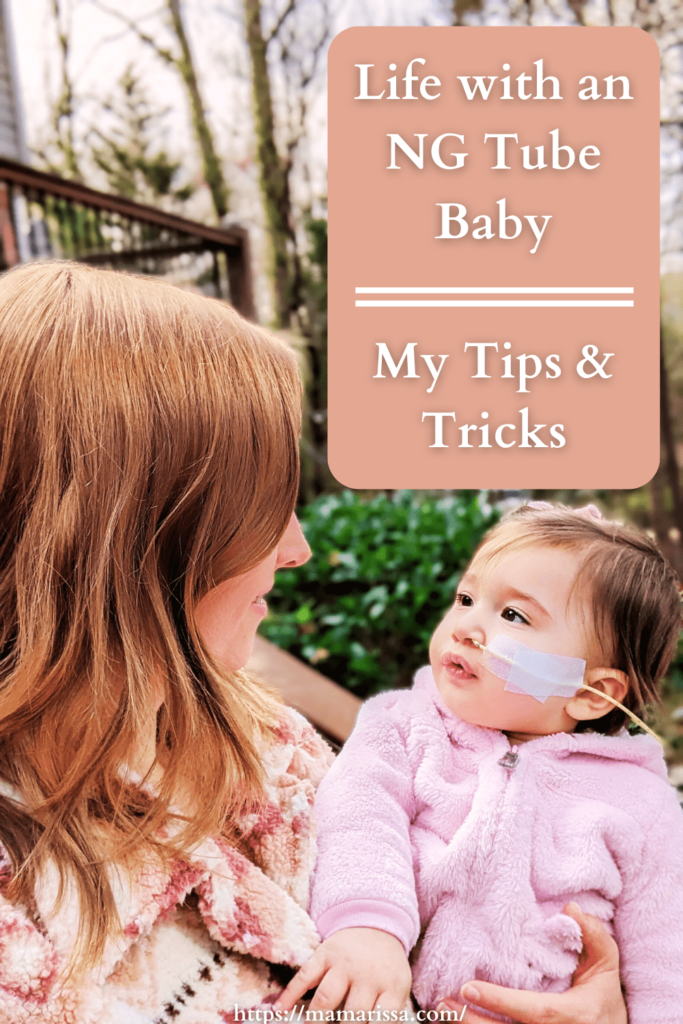
Of course you can ask your baby’s doctors and specialists about any concerns you have – and I certainly encourage you to do that. But in my experience, they don’t always have useful advice for your everyday life … as you will see later in this post.
So perhaps the practical experience from one mama to another can be of some help to you, I’m going to share with you the ways in which I have learned to adjust to life with the NG tube over the past ten months. And I hope that you will share any additional tips you might have in the comments after reading.
Hey Mama, if you find my blog posts helpful, would you help support this blog by making purchases through product links on this page? It will not cost you any extra but the commissions I receive as an Amazon and brand affiliate help to cover the costs of operating this blog so that I can keep it running ad-free. Thank you so much for your support. You are literally the reason this blog was started and the fuel that motivates me to keep it going!
Please note that I am not a medical professional and nothing in this post should be taken as medical advice. Please speak with your child’s doctor about any NG tube-related concerns.
How to Dress Baby with an NG Tube
Something as simple as putting clothes on your baby can become an obstacle when he has an NG tube.
If your baby is still tiny and doesn’t move around enough to be able to pull the tube out, he probably only needs it taped to his cheek. In this case, it will not interfere with his clothing – for now at least.
However, if your baby is active enough for the tube to get caught on things, you will probably find it necessary to tape the extra length of the tube to his back. This is what we did with my daughter.
Even though my daughter was only 3 1/2 months old when she got her NG tube, we were pretty sure it was going to get pulled out quickly if we didn’t do something more than a piece of tape on her cheek. So we gave it some slack and taped it to her back.
But this presented the clothing crisis. Okay, maybe not a crisis exactly. But I was wondering how I was going to dress her in a way that still allowed access to the tube. If you are in a similar situation, here are some tips to help you dress your baby:
1. Pull the Tube out an Arm or Leg Hole
If you dress your baby in onesies, just pull the excess tube length out of an arm hole or a leg hole – whatever makes more sense for the length you have and where it’s taped on your baby’s back.
If you put pants on over a onesie, you can still pull the tube through the leg hole of the onesie. Just pull the side of the pants down a tad or pull the side of the onesie leg hole up a bit so that the tube doesn’t get kinked.
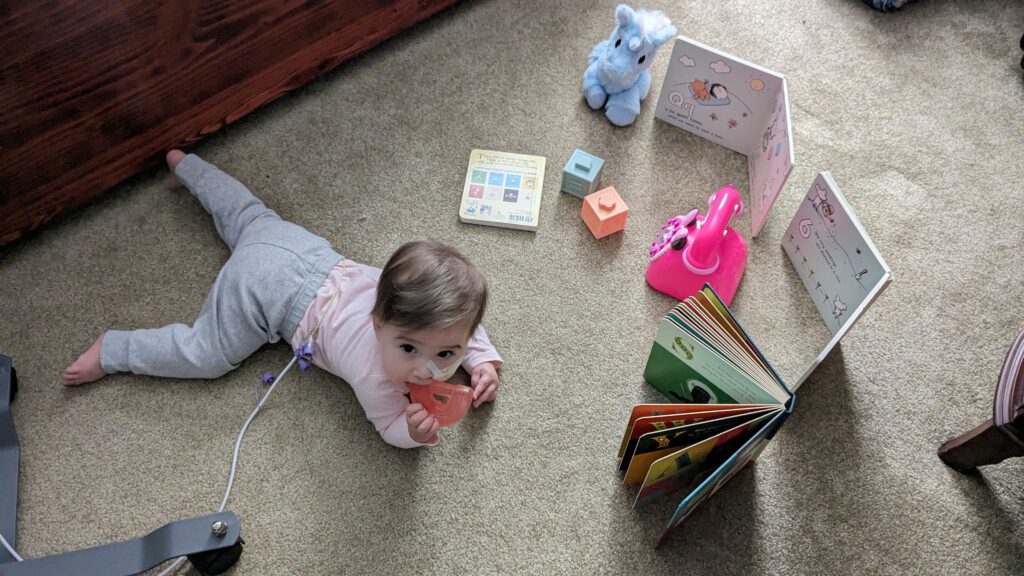
Alternatively, if you have a long enough tube, you can pull it all the way though the pant leg. Or, you can pull it through the pant leg even if you don’t have enough length. When you need to hook up the tube for a feed, you can just pull up the pant leg to access the NG tube.
Read about why my baby has holes in her heart here.
Once your baby is old enough for clothes not to bunch up as much, sometimes the easiest way to dress him is to use a shirt instead of a onesie. This way you don’t have to feed the tube through any part of the clothes. It just hangs out the bottom of the shirt.
2. Request Longer Tubes
Sometimes the hospital and/or your DME (durable medical equipment) supplier will give you short tubes. This makes it difficult or impossible to pull the tube out of an arm or leg hole in your baby’s clothes.
But don’t assume you have to use the short tubes. Ask for the longer 91 cm/36in tubes. I didn’t know I could do this until a friend told me she’s had to do that with some of her daughter’s DME supplies. She said I just had to ask them to overnight some longer tubes to me (we were in the middle of a rather frustrating short tube situation at that particular moment).
So I called my daughter’s DME company to request they send me longer tubes and they readily accommodated. Problem solved!
You can do the same. Using a longer tube will give you enough length to tape it to your baby’s back and pull it out one of the extremity holes of your baby’s clothing.
Pro Tip: Double check everything the DME company sends for your baby’s feeding supplies each month to see if you actually use all of the items they send. If there are things you don’t use, let them know so they do not keep sending those particular items. Also check with the billing department to see which items are covered by insurance. Even though they send it all to you and submit it to insurance, your insurance company may not cover every item. If insurance does not cover something, you can decide if it’s something you really need or not. If there is something you need that is not covered by insurance, check around to see if you can purchase it from a store yourself cheaper.
How to Go Out with NG Tube Feeds
Getting out of the house is challenging with any baby. So the thought of having to take your NG tube-fed baby out of the house can feel downright overwhelming, even scary!
When I brought my daughter home from the hospital with an NG tube, I thought sure I would not be leaving the house unless it was absolutely necessary. Unfortunately, numerous doctor appointments usually meant that “absolutely necessary” was several times each week.
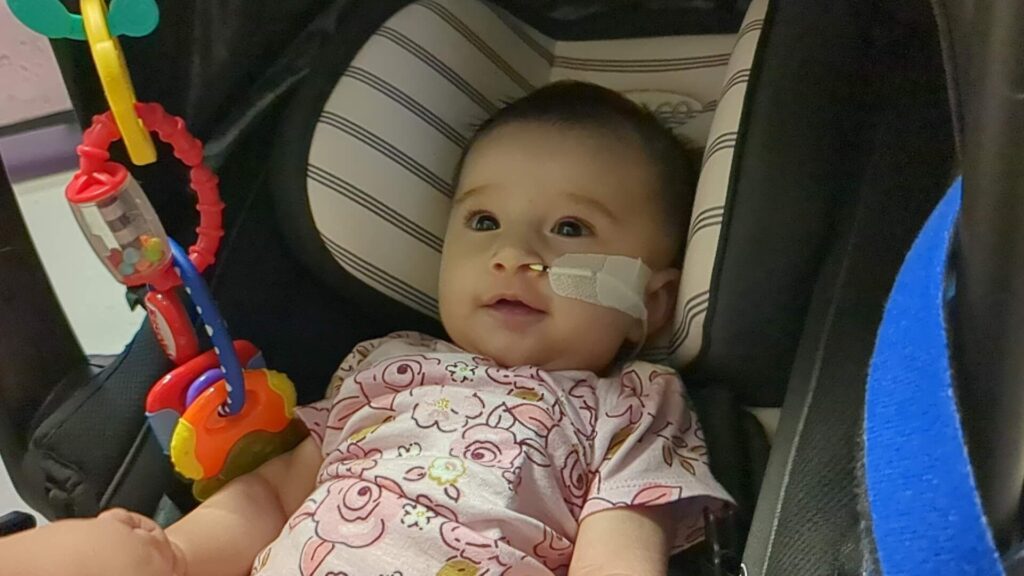
I would imagine you are very likely in a similar boat, Mama. But don’t worry. It’s not as scary as it sounds. You just have to find a going-out plan that works for you. Here are some tips based on my experience:
1. Work Around Gravity Feeds
If your baby is on gravity feeds (the kind that hang from a pole and drain into their belly as fast as gravity allows), giving a feed while out might be a little challenging, but still doable.
If you currently have the 60ml syringes for gravity feeds, it might be a little messy to try to store and carry around a gravity feed when it’s not in use. You can ask your baby’s DME company to send bags instead so that they can be capped and sealed shut. When you go out, you will just have to hold the bag above your baby to administer a feed.
I did not have the bags when my daughter was first on gravity feeds. In fact, I did not even know about the bags. So I mostly just worked our outings around her feeding schedule. Which was not super fun. But it is an option if taking a gravity feed out just doesn’t seem feasible for you.
Personally, if I had to go the gravity feed route again, I would make sure to get the bags.
2. Decide on a Feed Pump Carrying Method
If your baby has a feed pump (a machine that controls how fast or slow your baby receives feeds), it’s much easier to go out during feeds. The machine and the feed bag can both go inside of a backpack of some sort and it can be running while you are on the go without any assistance from you. All you need to do is decide what carrying method works best for you.
At one point, I tried to use a special backpack the DME company sent. It was supposed to make it easier to keep the bag upright and keep the machine in place. But it was actually just a catastrophe the few times I tried to use it. In my opinion, it was not designed well and would drop the machine and/or bag out as soon as you unzipped the backpack.
I found the best mode of feed transportation for me was to put it either in an outside pocket of the diaper bag or in my own purse-backpack. You can also use a regular toddler backpack, but then it is one extra thing to carry when you go out.
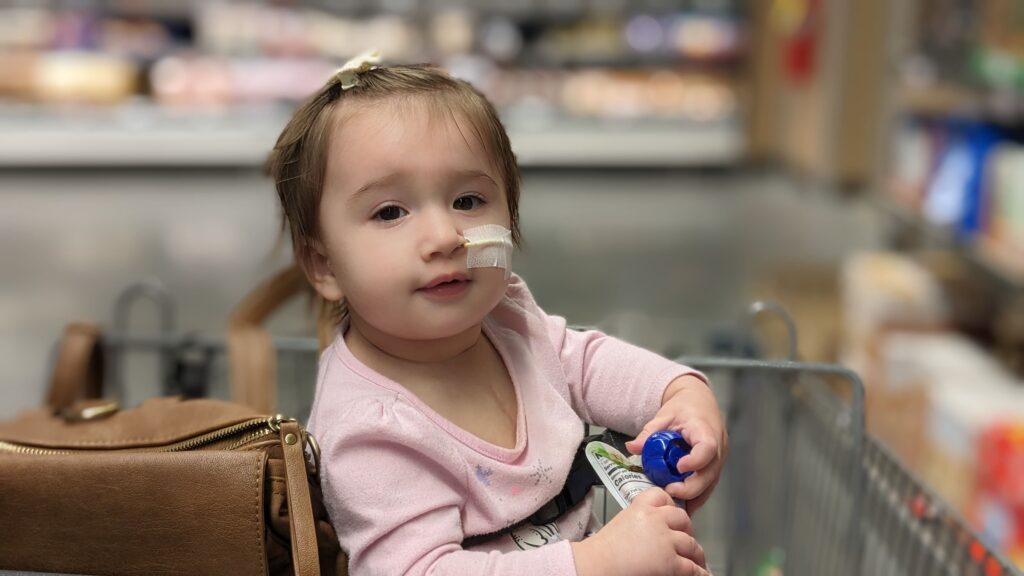
3. Pack Extra Milk/Formula
Obviously, when you are preparing to leave the house, you will need to make sure you have formula or pumped breast milk ready to go that you can take with you. But I recommend that you also bring one extra feed beyond what you expect to need.
I have had several occasions when I brought what should have been enough feeds for my daughter while we were out … only to have an extra late appointment or an unexpected errand interfere with my anticipated arrival time back home.
It’s always best to have an extra feed along. I make sure my extra feed is extra cold and then put it in the insulated part of my diaper bag to keep it from spoiling. Alternatively, for formula, you could just have a bottle with water and bring the premeasured amount of powder you will need to add.
Read how to prepare for your baby’s open heart surgery here.
Or, if you have any, bring some of the shelf-stable premixed formula along. This would definitely be the easiest option if you do not need to fortify your baby’s formula.
For breastmilk, you could always bring it frozen to preserve it longer. If you need to fortify it, you could, once again, bring the premeasured amount of powder along separately to add when you need it.
How to Sleep with Continuous NG Tube Feeds
This one is where I was shocked at the lack of help or concern from the medical professionals regarding my NG tube baby and her safety. When I brought up the possibility of my daughter getting strangulated by her tube at night while receiving continuous feeds, I was met with what was, to me, an unbelievable response:
“No one has ever really asked that before. It’s never come up as a problem.”
*Insert shocked emoji face here*
Really? No one?
Mama, please do me a favor. If you are reading this and you have also had this concern for your baby, please leave a comment below. Am I truly the only mama who has worried about this? I find that very hard to believe.
But whatever the case may be on the frequency of that question coming up, apparently the medical community (at least my daughter’s) is not overly concerned about this topic.

So let’s just do a quick recap on those baby care classes we took during pregnancy:
- Bed-sharing is a big no-no.
- Putting any sort of stuffed animal or blanket or bumpers in the crib is forbidden.
- Putting baby to sleep on her back is essential.
… But we are totally fine with leaving a long tube with strangulation capabilities in the crib and attached to a baby all night long?
This completely baffles me.
Clearly, I was not going to receive any valuable advice from my daughter’s medical team on this issue. So I had to come up with my own safety-hazard-mitigation plans.
1. Keep the Tube at the Feet
One simple way of dealing with this nighttime safety issue is to do your best to keep the tube as far away from baby’s neck as possible. And the best way to do that is to keep it inside baby’s jammies all the way to the foot hole. You will need footless pajamas for this, of course.
When I would lay my baby down at night, I would also make sure the pole was at whatever end of the crib her feet were at. This way, at least it was less likely that she would get it wrapped around her neck unless she did a complete 180 in the crib.
This is a possibility, especially if you have an active sleeper. And as my baby got older, she did get more mobile and active in her sleep. That is when the next tip became necessary.
2. Keep Baby Close
Now, I am not going to tell you to bedshare with your baby. I am not going to assure you that it’s perfectly safe to do so either. All I am going to tell you is what I did with my baby to keep her safe the best way I knew how.
I brought her into my bed. Because the older and more active she got, the more she was able to get tangled up in her tube at night. I went with my mom gut and kept her close, waking with her every move and checking her tube situation just as often.
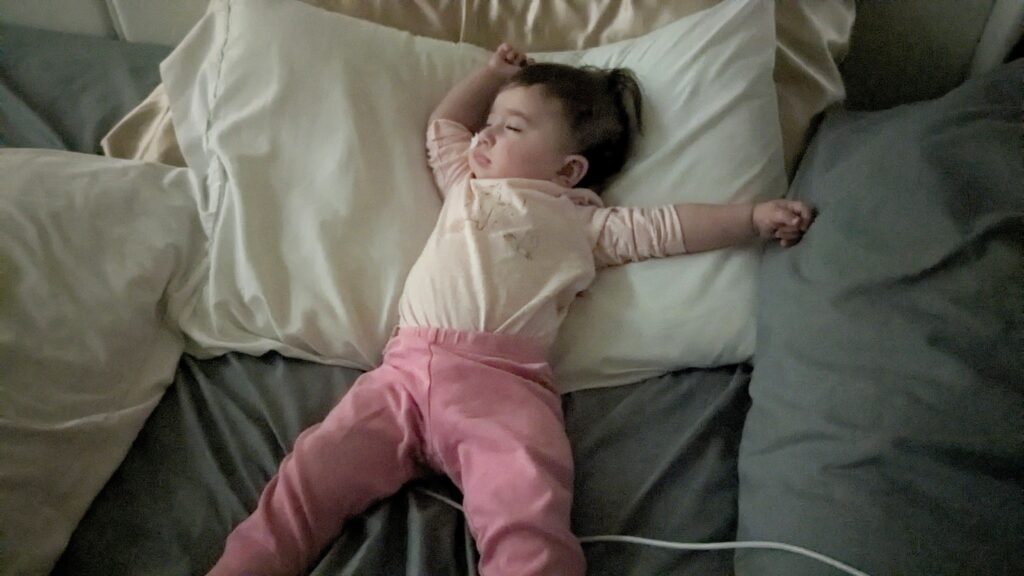
When she was in her crib, I would wake up if she woke up. But I did not necessarily wake up whenever she moved or rolled over. But in bed with me, I always made sure to have at least my hand on her or my arm around her so that I would know if she was rolling or moving. Personally, I felt much safer this way, knowing that I was actively checking that the tube was not wrapped around her throughout the night.
At the very least, I would recommend having your baby’s crib in the same room as you. Personally, I feel like the closer I am to my baby, the easier I can sense if something is not right.
You could also use an oxygen monitoring device. But that did not work for us because of too many false alarms and frequent malfunctions. Use your own judgement on that (unless, of course, your baby’s doctor recommends you keep a monitor on her. In that case, do your best to find a good one and keep it on her).
How to Manage a Mobile Baby With NG Tube Feeds
Once baby is on the move, NG tube feeds become a lot more challenging during the day as well. What do you do with the feed while it’s running?
This is especially difficult if your baby is on continuous feeds. You can’t put the feed in a backpack and strap it on them when they are crawling. You can’t leave it on the pole or it will tip over whenever baby crawls more than a couple of feet (yes, I speak from experience). What is an NG tube baby mama to do?
1. Put the Feed in a Truck
If baby is just starting to crawl and not super fast yet, you can put the feed pump and feed bag in its own transportation system. Essentially, you are giving the feed wheels to go where your baby goes without you having to follow baby around every millisecond. The way that I did this was by putting the feed pump and bag into my daughter’s toddler-size backpack and placing the backpack in the bed of this Green Toys dump truck (it’s just the right size to fit the toddler backpack).
You will still have to keep an eye on the feed, of course, to make sure the tube isn’t getting wrapped around toys and furniture or pulled between a stuck truck and a baby in motion. But for us, the truck was a huge help for a period of time.
This worked well for my daughter for about two months until she got too fast for the dump truck to keep up with her turns and too fast for me to correct its course. Fortunately, in our case, about the time we were having a lot of snapped tubes due to high speed chases and tube tangles, my daughter was able to handle condensed feeds and no longer required the continuous feeding.
2. Contain Baby During Feeds
Once baby is a fast crawler, a cruiser or a wobbly walker, the best method I have found for preventing tube pulls and snaps during feeds is to contain my daughter for the duration of the feed.
I know, this is not always desirable for the baby/toddler, which can be frustrating for everyone. But it is the only way I know of to prevent tube tangles and pulls until my daughter is sturdy enough and strong enough to carry the backpack on her back. If you have some better ideas than containment in the meantime, I would love to hear them in the comments!
Read “It Fells Like Years Ago: What it’s Like on the Other Side of Baby’s VSD Repair“.
But otherwise, here are the most entertaining modes of containment at my house: The bouncy, the bath, the outdoor baby swing, rides in the Cozy Coup and the highchair either for coloring at the counter or during meals.
The Cozy Coup rides have been a huge hit with both my NG baby and her 6-year-old big sister! We keep ours inside and use it as an easy distraction during feeds and fussy times. It has a handle on the back for easy adult pushing which is helpful. It also has an insert that can be placed in the bottom for a baby to sit in it without falling through.
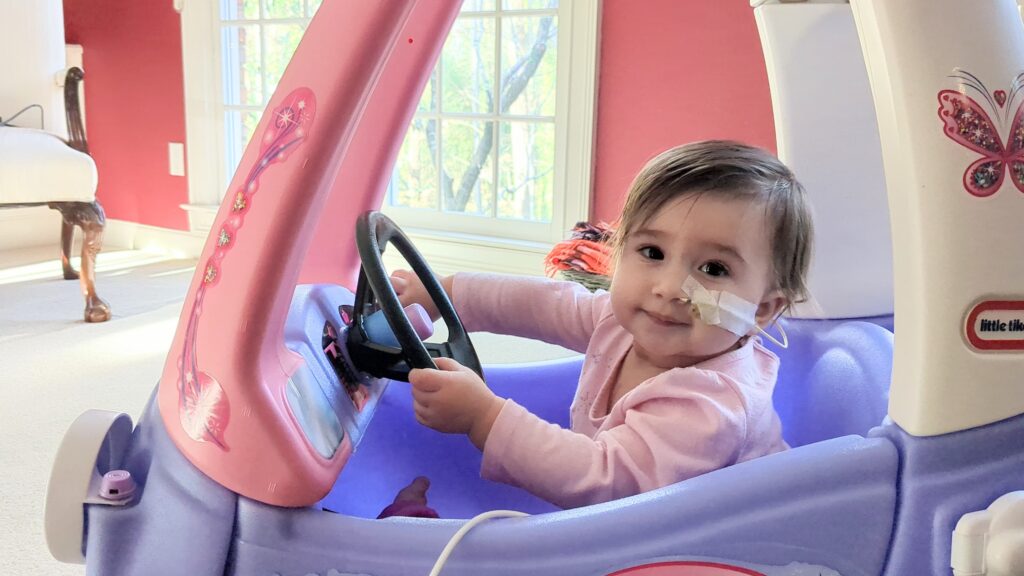
Now, I have to put a little caution here on the bouncy. My daughter’s physical therapist told me that bouncers and exersaucers are not actually good for babies’ hip alignment and joint pressures. So she advised me not to use it more than 15 minutes a day if I can help it. So maybe don’t use the bouncy or exersaucer for every feed. But it is a helpful option to have.
You can also make one of baby’s feed times simultaneous with bath time. You could even put him in an outdoor baby swing while his feed is running. I have done that a couple of times. And if your little one likes to color, tape some paper to the counter or highchair tray, strap him in and give him some crayons (with supervision of course).
And lastly, give feeds in the highchair at mealtimes as often as possible so that baby will associate getting full with mealtimes and eating – or at least tasting – food.
Dealing with Comments About the NG Tube
And finally, I want to address something we all encounter with our NG tube babies. The comments. Sometimes from strangers, sometimes from friends, sometimes from family members.
People ask questions and make comments about the NG tube because it’s something they haven’t seen very often, if ever. They perhaps don’t understand why your baby needs help with feeding.
To be honest, before my baby had a feeding tube, I don’t think I would have understood why a baby like mine would need one, even if it were explained to me. I would have wondered why she couldn’t just take a bottle. I would have wondered why she couldn’t just nurse more since breastfeeding works off of supply and demand, right? I would have wondered why she still needs it now that she is medically stable.
I probably would not have understood a mama in my situation. Until I got here, living it.
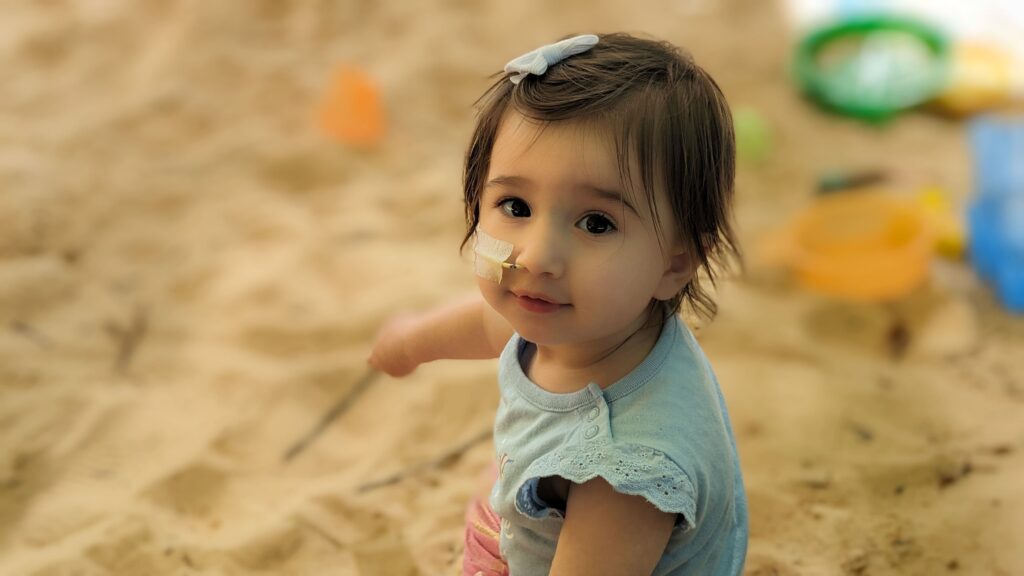
I know it can be hard to hear the comments or be asked question sometimes. It can make us feel guilty, like we have somehow failed as parents. Or it can make us feel self-conscious on behalf of our child, as though they won’t be viewed the same as other kids.
But please don’t shrink away from those questions and comments. I have two very good reasons why we need to remain open about our babies’ NG tubes.
First, because of something my friend said to me. Her 3-year-old daughter has had an NG tube her entire life. And when I brought my daughter over to her house for a playdate, she made the comment that it’s good for the kids to see that each other has an NG tube to help normalize it.
I agree. We need to normalize it. For the sake of our children who have to live with a tube taped to their faces.
Second, because of other children who do not have NG tubes. I took my kids to a park the other day and a little girl – probably 7 or 8 – walked up to us and asked if my baby was okay.
I told her yes and explained that my baby had a big hole in her heart when she was born that made her body work extra hard and need extra energy. I told her my daughter needed a feeding tube to put extra milk in her tummy to give her more energy. The girl nodded and walked away.
She came back several minutes later and asked how the milk can get into her belly from the tube. So I showed her the connecter at the end of my daughter’s tube. I told her how it hooks up to another tube connected to a bag of milk that is pushed through the tube with a little machine. She took it all in with the simplicity of the child she was.
I just loved her innocence. I loved that she wanted to know how it worked just for the sake of knowing something new. I love that she didn’t show a flicker of judgement, confusion or doubt. Just open, honest curiosity. The kind that invites learning instead of forming impressions about a person.
That’s the way it always is with kids who ask about my baby’s tube. They aren’t looking for a reason to pity or form an idea about my daughter. They just want to know. And I think it’s important that we tell them. So that it’s just a fact for them rather than something to influence their perception.
Personally, despite my love-hate relationship with the tube, I am grateful to have had this method of feeding my underweight baby when she needed it most. If it weren’t for her NG tube, I believe she would have been weaker and smaller for her two major surgeries as an infant. So I’ll gladly explain why she has one to anyone curious and humble enough to ask.
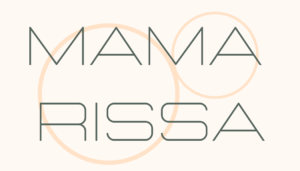
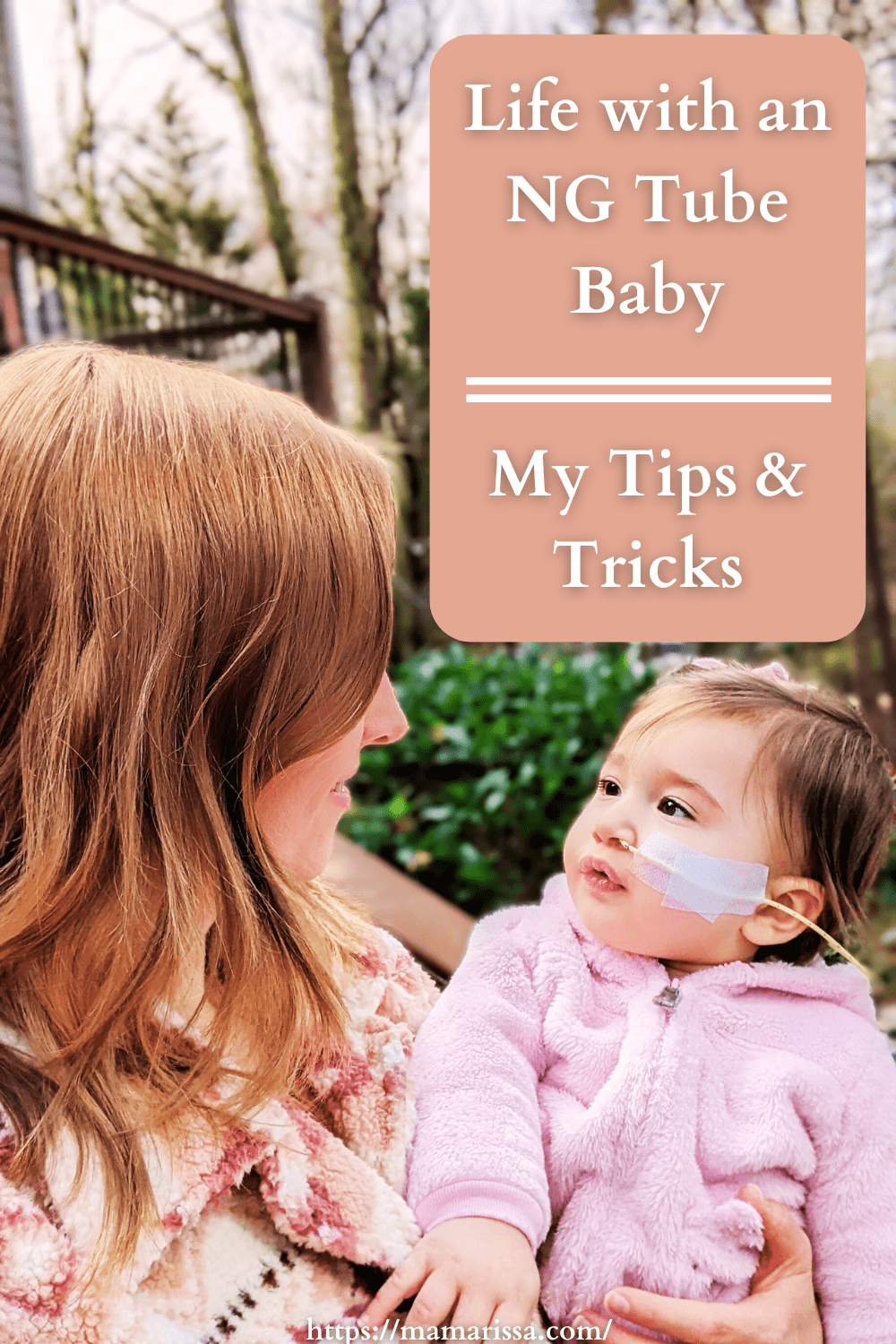

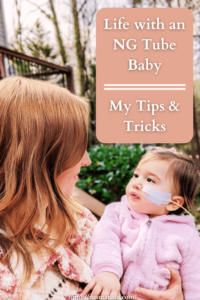



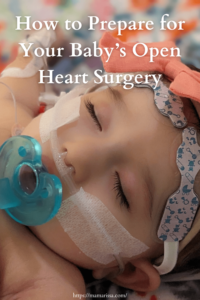
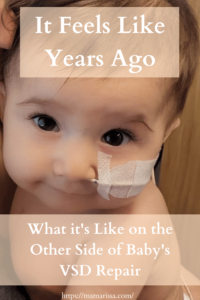
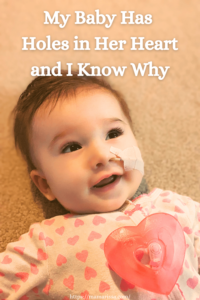


Leave a Reply